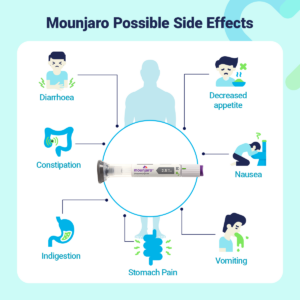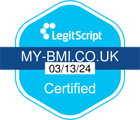Due to the fact that Semaglutide is a relatively new drug, and used off-label in certain cases, some people question the safety of it and whether or not there are any risks in taking it.
Although Semaglutide hasn’t yet been approved for weight loss purposes, it was approved as a treatment for type 2 diabetes in the UK early in 2019, so it’s already deemed safe enough for that purpose.
In the UK, the MHRA are the regulating body that decides whether or not a medicine is granted a license for use.
They approved Semaglutide injections (Ozempic) as a diabetes treatment in 2019, and as the regulating body for medicines within the country, they wouldn’t have approved it for use if they believed that it was unsafe in any significant way.
However, this doesn’t mean that it’s safe for everyone to take – it’s still a prescription medication and should be treated as such, and with prescription medications come risks, such as adverse reactions, interactions with other medicines, and each individual’s tolerance to the medicine.
The Ozempic patient information leaflet does state that it’s unsafe for some people, such as those who have type 1 diabetes, or those who already have diabetic ketoacidosis, so if you suffer from either of these conditions, you should avoid taking Semaglutide and instead talk to your own GP for advice on what you may be able to take as an alternative.
Are there any side effects of Semaglutide?
As with all medications there is a risk of some patients experiencing side effects when you take Semaglutide.
Most of the side effects of Semaglutide are generally gastrointestinal-related due to the way that the medicine works in the body.
Some of the most common Semaglutide side effects that have been experienced by some users include nausea, diarrhoea and vomiting.
However, these side effects usually subside after a few weeks as your body adjusts to the medication.
You may be able to avoid some of these side effects by making sure that you aren’t eating too much food whilst taking Semaglutide injections.
The GI side effects are often a result of over-consumption, so making sure that you only eat what you need to be satisfied can help to significantly reduce the severity of some of the side effects.
There is also the risk of more serious side effects with Semaglutide, as it’s a prescription medication designed to treat type 2 diabetes mellitus (T2DM).
One of these serious side effects is the risk of developing pancreatitis.
Because of this, the patient information leaflet for Semaglutide states that if you experience severe and persistent stomach pain, you should see your own GP or seek urgent medical attention.
There is also a risk of hypoglycaemia (low blood sugar levels) if Semaglutide is used alongside any other medicines that help to lower blood glucose (usually any other anti-diabetic medications).
You should speak to your GP if you’re already taking anything that might affect your blood glucose levels, such as metformin, any types of insulin, or other similar treatments.
For a full list of side effects, you should see the patient information leaflet of whichever Semaglutide product you’re taking:
You should familiarise yourself with the patient information leaflet for the medication that you’re interested in, as this is the best way to find out all of the relevant and important information that you need to know before you take it.
The patient information leaflet is there to guide you and give you all of the warnings and side effects before you even begin taking any medication, so please do make use of the links provided.
These are free to access and contain vital information about each medication.
How much clinical research is there on the safety of Semaglutide?
Before Semaglutide was approved as treatment for T2DM, it had to go through the same rigorous testing procedures that all other drugs must go through in order to be granted approval and a license for use.
This means that there are plenty of studies which include data on the safety of Semaglutide, and it is often compared to other GLP-1 Receptor Agonists, such as Liraglutide.
In addition to this, each new form of a drug (such as Rybelsus which is Semaglutide in tablet form) has to undergo a rigorous trial and testing period to make sure that it’s safe for use in humans.
There are currently two Semaglutide products on the market that have been approved for use in the UK, so the safety of Semaglutide has been accurately assessed by the developers of the drug and decided by the MHRA that it is safe to be used in UK adults for the purpose of treating T2DM.
Current studies into Semaglutide as a weight loss medication also show the drug to be safe and effective, which is promising data if Novo Nordisk are looking to apply for a new license for the drug to be an anti-obesity treatment.
One study that took place in 2018 evaluated the safety and efficacy of Semaglutide in patients with T2DM, and the results showed that the injections were safe and effective, with a high risk of gastrointestinal side effects (similar to one of its sister medications, Liraglutide).
However, as these side effects are present with other GLP-1 receptor agonists, Semaglutide was tolerated well by participants, and the GI side effects subside with time, the risk of side effects was not deemed detrimental to the safety of the medication.
Another study in 2019 compared Semaglutide to Canagliflozin (another treatment for diabetes), and findings revealed Semaglutide to be the superior of the two medicines when looking at safety and efficacy of both.
Most studies that have looked at the safety of Semaglutide as a medication mention the risk of gastrointestinal side effects such as nausea and diarrhoea as these are the most common occurrences when taking the medication.
However, many people are able to tolerate these side effects, especially once they’ve subsided after the first month or so of treatment.
Because of this, Semaglutide is deemed safe to use due to the low risk of any serious adverse reactions.
There was a worry that use of GLP-1 receptor agonists such as Liraglutide (Victoza/Saxenda) and Semaglutide (Ozempic/Rybelsus) could increase the risk of patients developing thyroid cancer.
However, it should be noted that this is due to initial studies when the medication was tested on laboratory animals.
It is currently not yet known whether or not these medications can affect humans in the same way, but current data does not show any correlation between thyroid cancer and Semaglutide.
However, due to the potential, we would recommend that if you have an underlying thyroid condition, you should mention it during your consultation along with any other medical history so that your prescriber can make an informed decision based on your own health and their expertise with Semaglutide.


















